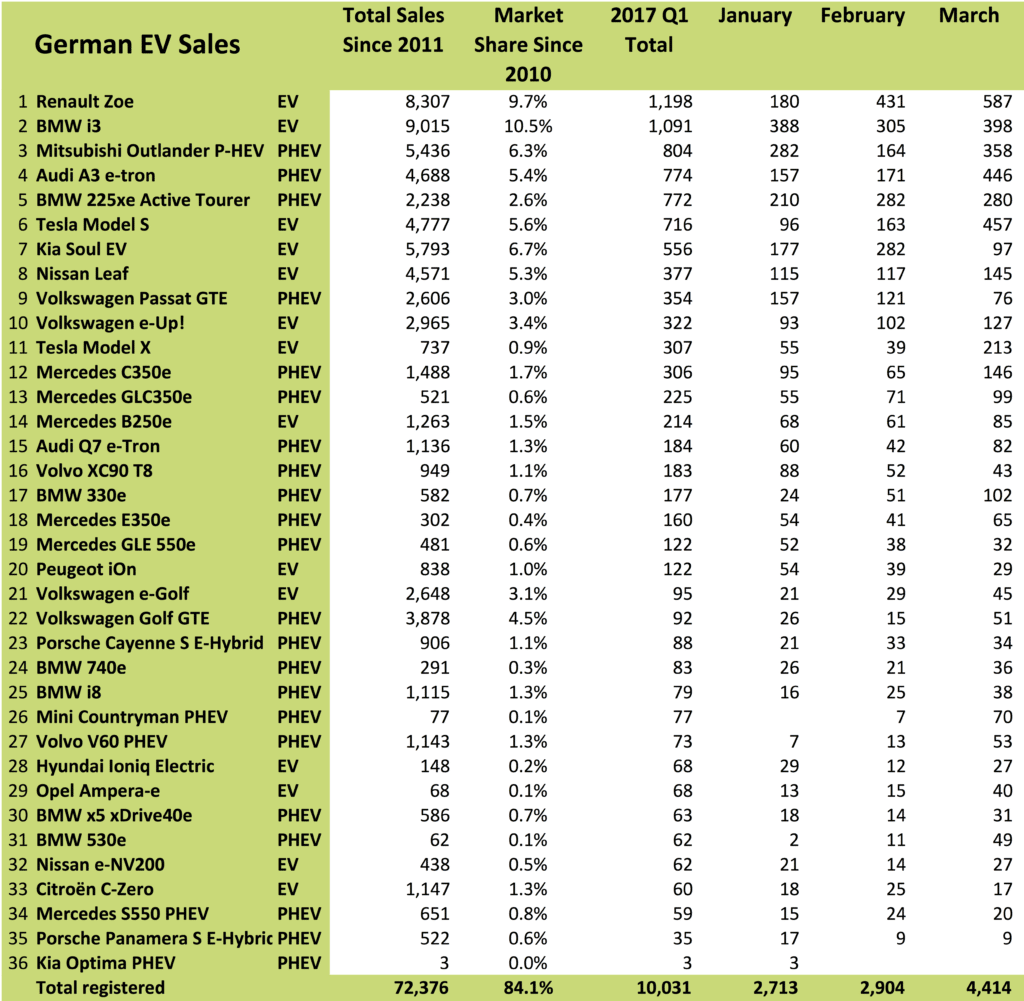No Results Found
The page you requested could not be found. Try refining your search, or use the navigation above to locate the post.
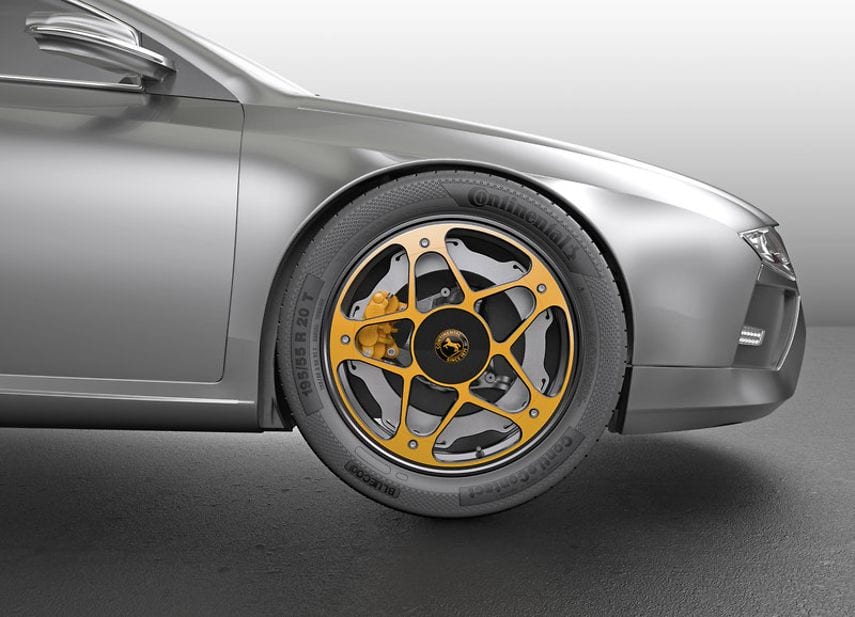
German Chancellor Angela Merkel this week reaffirmed her commitment to having 1 million EVs on the country’s road by 2020. In an interview with German YouTuber Lisa Sophie, Merkel reportedly said that the country has not abandoned its commitment to its one million EV goal by 2020 but that not enough was done up to now, signaling a possible ramp-up of the country’s efforts in the next two years. Merkel did not accept all of the blame for the slow pace but laid some of the responsibility on automakers which she doubts were sufficiently innovative enough to progress the technology.
Merkel will meet with local government officials on the 4th of Septemeber to discuss emission targets and indicated that around $600 million would be made available to improve urban transport infrastructure.
Although EV sales in Germany skyrocketed this year, the country so far only has just over 100,000 EVs registered. German EV sales data released this week showed that at the end of July nearly as much EVs have been sold as for the whole of 2016. EV sales in Germany are expected to continue its strong performance, supported by initiatives such as that of Nissan which announced that it would offer a scrapping bonus of EUR2000 ($2,348) for buyers converting from ICE vehicles to its Nissan Leaf or a Nissan e-NV200.
In related news, Chinese EV sales data showed a 30% rise in EV sales for the year to date over the corresponding period in 2016. It’s wattEV2buy’s forecast that China will reach its target of 2 million registered EVs by 2020, and even exceed it as more models become available in the next two years. China is already standing more than 800,000 units of which 200,000 has been registered this year alone. It is our belief that the Chinese EV market is set to reach its one million EV milestone by the end of the year, in light of historically stronger second half sales.

The Indian power producer, JSW Energy, a thermal power producer with nearly 5,000 MW of capacity is set to shift its business to align itself with more sustainable energy offering. Although this strategy is adopted by most power producers JSW Energy’s shift is more radical, as it includes investing around $550 million in new businesses including the manufacturing of an electric vehicle by 2020. In an interview with the Hindu BusinessLine, JSW Energy’s CEO admitted that the company is venturing into a new competitive space but that it bets on the growth in the vehicle sector in India due to the expected disruption by EVs. The company is set to work with technical partners and have a 60% local content goal.
As the rush to EVs starts to accelerate auto part companies are investing more and more in the development of new technologies, helping to advance electric vehicles. The Korean auto part company, Hyundai Mobis, this week announced that its the first South Korean company to develop a bi-directional on-board charger (OBC) for vehicle-to-grid (V2G) applications. Industry commentators have been quick to claim EVs V2G capability as a key attribute of the technology, but to date, no production vehicle comes equipped with the application as a standard feature. A contributing factor for the slow adoption of V2G technology is the slow development of software to optimise the charging / depleting of batteries so that drivers are not left stranded due to supplying the grid with power.
Other technology advancements unveiled this week include the German auto parts company, Continental, introducing a new lightweight wheel and braking concept for EVs. In a press release by the company highlighted the technology as follows:
As the push for cleaner cities drives the EV revolution forward, we are seeing more and more electric delivery vans entering the marketplace. Gone are the days of an EV delivery van being associated with the defunct Azure Connect or the small Renault Twizy Cargo which hardly had enough space or range to cover the average daily distance for delivery vehicles of 65 miles. The past month has seen the introduction of production versions of the Daimler Fuso E-Cell and the new Renault Kangoo ZE. This week two more delivery vehicles made the front pages. Ford and Deutsche Post subsidiary, Street Scooter, this week introduced its first jointly produced E-Van, the StreetScooter Work XL in Cologne. The Work XL is based on the Ford Transit Van and has a load capacity of 20 cubic meters, a modular battery system that could be sized from 30kWh to 90kWh for a range of between 80km and 200km. The 22kW onboard charger allows for an average charging time of three hours. Each WORK XL could save around five tonnes of CO2 and 1,900 liters of diesel fuel each year. StreetScooter will assemble around 150 units by the end of 2017 at its Aachen plant and ramp up to 2,500 units by the end of 2018. The Deutsche Post DHL Group is the largest operator of electric vehicles in Germany with a fleet of 3,000 StreetScooter Work and Work L vans and 10,500 pedelecs.
In the US, Chinese owned and Californian based EV start-up, Chanje, announced that it would introduce its first medium size fully electric delivery vehicle, the V8070 by the end of the year. The V8070, below on the right, has a 100-mile range with a 6,000lbs payload and 7.2kW onboard charger. Chanje has raised funding of $1 billion from various partners including Hong Kong-based FDG Electric Vehicles Limited which manufacturers the Yangtze EV in China.
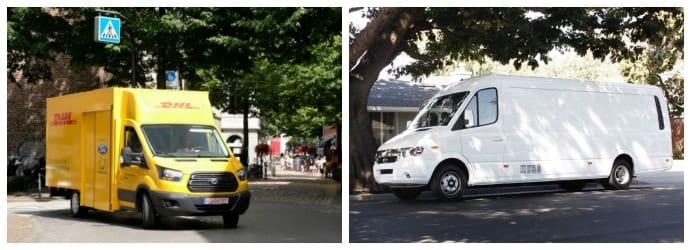
As the race for electric vehicles hots up so it does for autonomous vehicles as car makers try and regain the edge it lost in the EV sector to tech start-ups. Fiat Chrysler Automobiles (FCA), dead-last in the EV race, this week joined the BMW Intel self-driving car alliance as the company gears-up to produce self-driving cars by 2021. The BMW led alliance also includes Intel’s recently acquired Israeli tech company, Mobileye, Delphi Automotive, and Continental. Together the alliance will have 140 self-driving test vehicles on the roads by the end of 2017. Interestingly enough FCA is also a partner with Google’s Waymo where it developed and deployed autonomous Chrysler Pacifica minivans.
The Michigan Economic Development Corp funded American Center for Mobility announced that it will start operating its autonomous vehicle testing ground in December 2017. The converted Willow Run facility, first used for airplane testing, is a two-and a half-mile highway test loop. Michigan, which has been one of the pro-active states in self-driving development invested around $110 million in the conversion and expects to develop a second facility by 2019 to represent urban driving conditions.
US Chipmaker, NVIDIA, which led the push into autonomous technologies ahead of its competitor Intel, this week announced its investment in two-year old Chinese self-driving truck start-up TuSimple. The undisclosed investment by NVIDIA was part of $20 million funding round led by Sina, the Chinese Social Media company. TuSimple recently completed a Level 4 autonomous trip from San Diego to Yuma, Arizona.
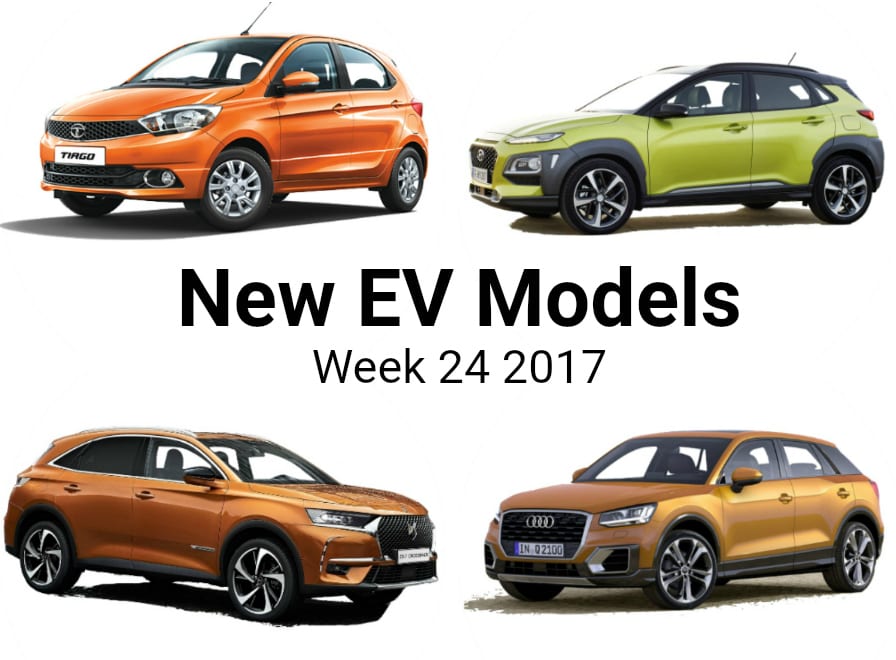
This week saw the announcement of four new EV models by Audi, DS Auto, Tata Motors and Hyundai. The four brands will release electrified versions of existing model ranges as they rush to enter the market.
Audi announced its intentions to launch an electrified version of the Q2 SUV for the Chinese market. The Q2 will compete with the BMW Brilliance X1 which is also specifically produced for the Chinese EV market.
PSA Group’s luxury brand DS announced that it will release an all-electric vehicle or PHEV every year from 2019 starting with the DS7 Crossback. In other news, PSA Group and Changan deepened their relationship in China with the intent to jointly develop electric vehicles in a similar fashion as the VW JAC JV announced earlier this month.
Tata Motors will enter the India market with an electric version of the Tata Tiago hatchback. The Tiago will be Tata’s first production EV. In 2015 the market speculated that the Indian company was to bring the Tata Megapixel to market in 2016 as its first EV but market conditions did not favor EVs at the time. The Indian Government has since embarked on a drive to change to 100% EV in 2030.
Hyundai revealed its latest EV, an electric version of the Hyundai Kona SUV. The car is expected to reach the market late 2018 and will be unveiled at the Frankfort Auto Show in September 2017. Although no specifics has been revealed the Kona is expected to have a range of 217 miles from a 50kWh battery and will be priced below $40,000. In related news, the Korean company announced that it will increase production of the popular Hyundai Ioniq with 50%.
Honda announced that it will release the Honda Clarity Electric in Oregon and California later this year on a three-year lease for $269 per month.
Tesla, now the 4th largest automaker in the world by market cap, has been in talks with the Indian Government to establish production facilities in the Asian country. Tesla CEO Elon Musk provided further incites in the company’s plans for entering the potential growth market by tweeting “In discussions with the government of India requesting temporary relief on import penalties/restrictions until a local factory is built.”
Tesla shares this week reached our target of $380 as per my forecast in Week 20, I hope you took advantage of the opportunity.
In Week 22 we reported on concessions agreed between the German Chancellor and Chinese Premier to delay strict ZEV type mandates to allow German automakers some breathing space. This week the Chinese Legislative Affairs Office published draft legislation ignoring the concessions. The proposed legislation will require automakers to sell new energy vehicles equivalent to 8% of total sales in2018, increasing by 2% annually to reach 12% by 2020. Chinese lawmakers and the Calfornia Resource Board met in China last week to expand cooperation on accelerating the deployment of zero-emission vehicles. The delegation also included officials from Chinese vehicle and battery manufacturers such as BYD, BAIC, Great Wall, Geely, Dongfeng, Yangtze Motors and a half dozen other vehicle and battery companies.
EV sales data for May 2017 published this week included data for Germany and China. I will do a complete breakdown of the sales again next month when June figures will allow me to do a deep dive at the halfway mark for the year. Headline data from Germany and China are as follows:
Germany: EV Sales keep powering ahead EV sales now nearly double that of the same period 2016. Total sales for the year to date stands at just over 17,000 units compared to 8,800 at May 2016. May 2017 EV sales in Germany was nearly treble that of May 2016 as 3,754 EV were added to the fleet compared to only 1,392 units in May 2016.
China: Chinese EV sales are recovering at a decent pace. EV sales in May showed a continuation of the trend started in March 2017. Chinese EV sales are now more than 50% higher than the same period a year ago. May EV sales of over 40,000 units bring the year-to-date sales to 134,000 units. Smaller cars like the Zhidou D2 and BAIC E180 still rules the roost. The new Chery eQ1 has also made the Top 20 list for the month.
GM announced this week that it completed the equipment of 130 Chevrolet Bolt EVs with its next generation of self-driving technology. The vehicles will be added to its fleet of 50 current generation Bolt EVs testing the autonomous technology on public roads in San Francisco Scottsdale and Detroit. The company reported that the new generation technology features GM’s latest array of equipment, including LIDAR, cameras, sensors and other hardware designed to accelerate development of a safe and reliable fully autonomous vehicle.

In related news the California DMV permitted self-driving truck start-up, TuSimple, to test its artificial intelligence (AI)-based Level 4 autonomous driving system on 420-miles of public roads from San Diego to Tucson in Arizona.
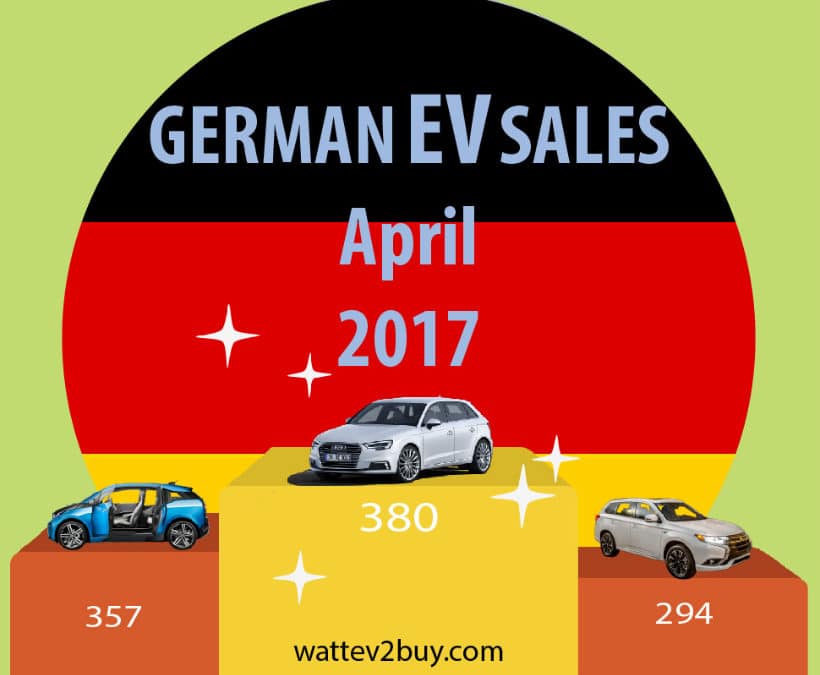
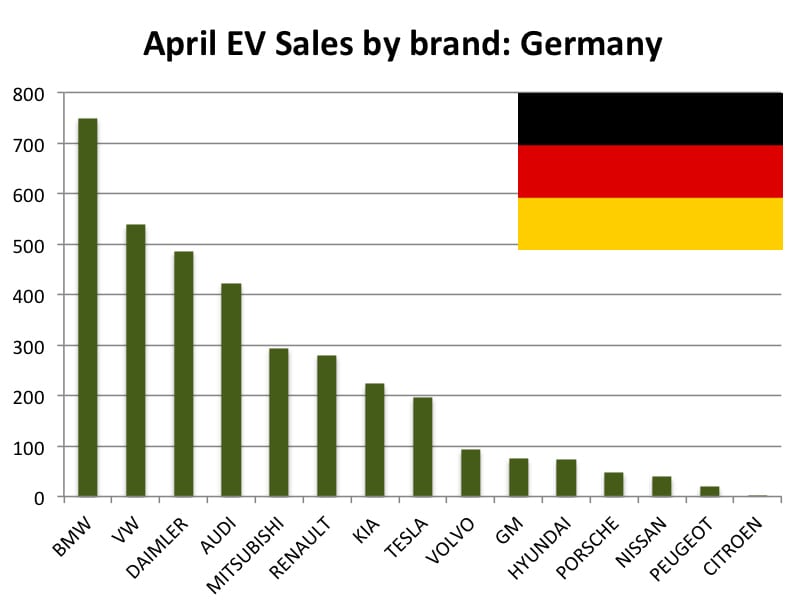
The pace of German electric vehicle sales just keeps on accelerating as the country’s April EV sales jumped 119% compared to the previous April, bringing the year-to-date increase to 82%, up from 77% in March. Battery Electric Vehicles (BEV) maintained a slight lead over Plug-in Hybrid Electric Vehicles (PHEV) with 6,843 units sold vs. 6,728. Plug-in Hybrids were, however, the leading technology for the month of April with 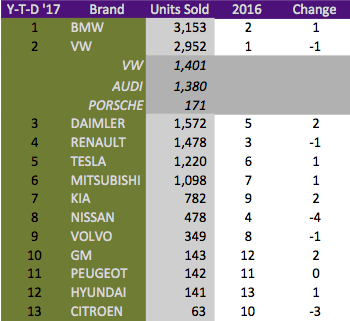 1,953 units sold vs. 1,587.
1,953 units sold vs. 1,587.
The Top EV brand in Germany is BMW, taking the crown from VW. The BMW i3, which kept on to its second position overall and the BMW 225xe Active Tourer accounted for nearly 80% of the German automaker’s total sales. Significant of the BMW i3 sales is that the consumer is shifting away from the i3 REx range extended PHEV, last years preferred variant, to the pure electric version. The ratio in 2016 was 474 i3 REx to 216 i3 BEV vs. 897 BEV to 551 REx now. The shift towards the pure electric version is an indication that consumers are getting more comfortable with the technology and that range anxiety is becoming less of a deterrent. Surprising is that Nissan lost a lot of ground in Germany, this was due to the fall in Nissan Leaf sales. The popular, yet dated Leaf, has been able to hold its commanding position in most other markets, so we have to ask the question if Germany is a sign of what’s to come. Nissan teased some pictures of the new Leaf, expected in 2018 this week. The VW brand was one of the other losers for the year-to-date, mostly due to falling Volkswagen Golf GTE and e-Golf sales. The new Renault Zoe Z.E. 40 was the most popular car in February and March but lost ground in April to the BMW i3, Audi A3, and Mitsubishi Outlander.
Smaller and cheaper models remained the top performers in Germany, but new models such as the Opel Ampera-e (rebadged Chevrolet Bolt), Hyundai Ionic and Mini Countryman SE ALL4 has yet to perform. In the luxury segment, Mercedes-Benz outsold Volvo, BMW, and Audi. Tesla remained the best performer in the luxury segment, maintaining its position, owning 10% of the total electric vehicle market in the country. The Toyota Prius, a top performer over the last couple of months in the USA and Japanese markets, is not yet available in the German market and it is unclear if it will be available here.
At this rate, Germany is expected to surpass its 2016 record with about four months to spare, a great achievement for the electric vehicle sector, boding well for global EV sales in 2017.
Please feel free to use the comment section below to share your thoughts on the German EV market and available models.
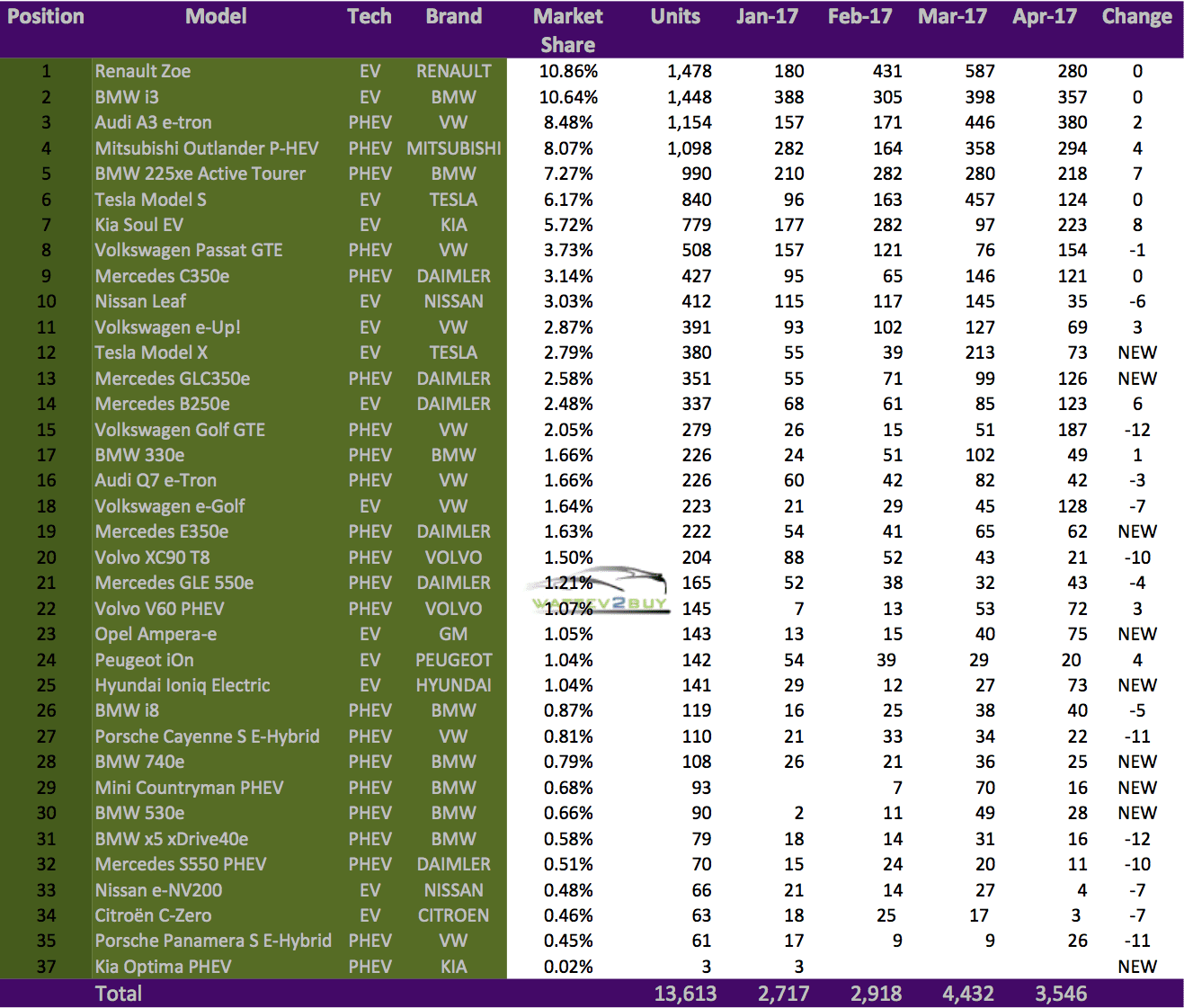
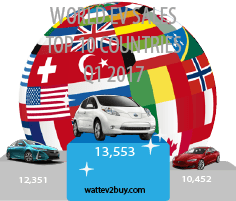
Now that all the Q1 data is in we can do a detailed dissection of the hottest quarter in EV history in which nearly 200,000 electric vehicles was sold. The headline data is that nearly 180,000 EVs were sold in the top 10 EV countries. Battery Electric Vehicles (BEV)  outperformed Plug-in Hybrid Vehicles (PHEV) by a long shot. A total of just over 106,000 BEVs were sold while only around 70,000 PHEVs moved off the dealership floor in the top 10 countries.
outperformed Plug-in Hybrid Vehicles (PHEV) by a long shot. A total of just over 106,000 BEVs were sold while only around 70,000 PHEVs moved off the dealership floor in the top 10 countries.
One of the standout data points is USA EV sales which overtook China as the best market for electric vehicles in Q1, making the USA the top EV country in Q1. The worst performer was The Netherlands, who fell out of the top 10. The Netherlands disappointing performance over the last couple of quarters does not bode well for the European country was seen, next to Norway, as one of the proponents of the technology. Only last year still did the Dutch Government contemplated a goal to be 100% electric by the middle of the next decade. It is unclear what caused the drop in EV sales in the Netherlands.
When comparing this quarter’s EV sales by country to their respective totals for 2016 one can see that the pace of EV sales picked up in most. If one should expect that by the end of Q1 EV sales should equate to roughly 25% of 2016, it is only China and The Netherlands that are underperforming. Chinese EV sales have lagged in January due to technical factors including a clampdown on EV subsidy fraud and the annual Chinese holiday, in which most industries shut down. Chinese EV sales have picked up the pace in the following months and the quarter still ended up 30% over the same period of the previous year. It can be concluded that EV sales for the first quarter in China are historically weak and Q1 2017’s performance is by now way an indication of a trend. Furthermore, the Chinese Government last week announced a plan to dominate the electric vehicle sector which should help the country to regain its stature. Japan, on the other hand, has picked up the strongest pace and has already achieved EV sales equal to 59% of its total 2016 sales. The Japanese EV market has the least variety of EV models available to consumers, and it is anticipated that the introduction of more models will stimulate the market further. Germany is the second best performer helped by a 77% improvement in EV sales on a year-to-year basis.
The top EV brand in the Top 10 EV Countries is Tesla for the second year running. Tesla announced in its April trading update that it sold just over 25,000 Models S and X globally. It is important to note that the figure repo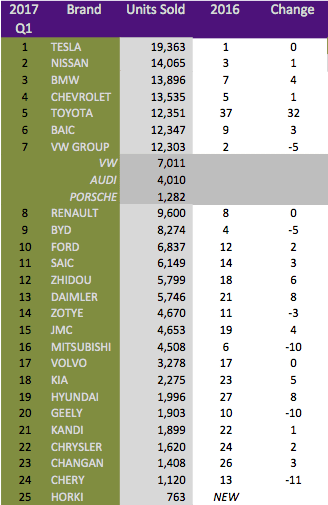 rted includes vehicles being shipped, while country sales data shows vehicles registered. Toyota is back in the Top 10 list of EV brands on the back of a well-received new Toyota Prius. Chevrolet did not shoot the lights out with its new mass-market EV, the Chevrolet Bolt / Opel Ampera-e. Most of GM’s sales came from the Chevrolet Volt PHEV. The company is criticized for producing a limited amount of the Bolt and is being labeled as a compliance company for that, a term used for auto manufacturers that only sell EVs in Zero Emission states to gain credits. The big losers included VW, BYD, and Mitsubishi. BYD has been the Top EV manufacturer for 2015 and 2016 globally and was at the number three position for most EVs sold since the start of the decade. Competition from the likes of BAIC and SAIC is the main reason for the companies bad performance. Up til 2016, BYD had the advantage of being first to market, but some new models that can compete on performance and quality with BYD entered the market since 2016. (This sentence could very well be used for Tesla in a couple of years). Mitsubishi fell a staggering ten places as the company has not updated its popular Outlander PHEV or introduced new models as a replacement.
rted includes vehicles being shipped, while country sales data shows vehicles registered. Toyota is back in the Top 10 list of EV brands on the back of a well-received new Toyota Prius. Chevrolet did not shoot the lights out with its new mass-market EV, the Chevrolet Bolt / Opel Ampera-e. Most of GM’s sales came from the Chevrolet Volt PHEV. The company is criticized for producing a limited amount of the Bolt and is being labeled as a compliance company for that, a term used for auto manufacturers that only sell EVs in Zero Emission states to gain credits. The big losers included VW, BYD, and Mitsubishi. BYD has been the Top EV manufacturer for 2015 and 2016 globally and was at the number three position for most EVs sold since the start of the decade. Competition from the likes of BAIC and SAIC is the main reason for the companies bad performance. Up til 2016, BYD had the advantage of being first to market, but some new models that can compete on performance and quality with BYD entered the market since 2016. (This sentence could very well be used for Tesla in a couple of years). Mitsubishi fell a staggering ten places as the company has not updated its popular Outlander PHEV or introduced new models as a replacement.
The Top 10 EV models are still lead by the Nissan Leaf, a phenomenal performance by the 7-year-old EV. The Toyota Prius replaced the Tesla Model S in the top two while the Tesla Model X performed the best of the 2016 Top 10 cohort. Newcomers Chevrolet Bolt, BAIC E-180, and the Toyota Prius replaced the BYD e6, BYD Tang and Mitsubishi Outlander in the Top 10 EV models list for Q1.
Please use the comment section below to share your thoughts on the EV market.
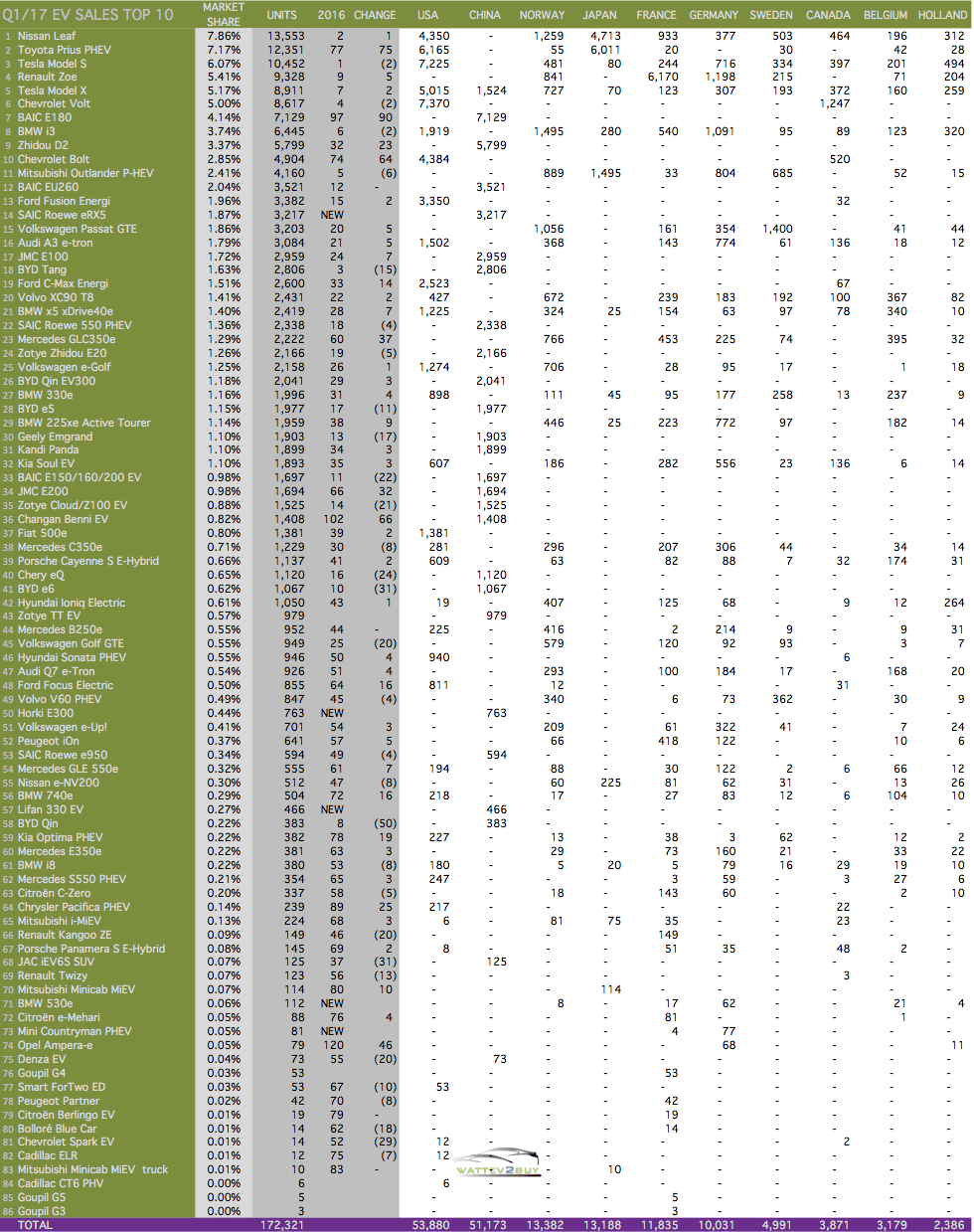
Note on data: The detailed data above does not include the UK, who keeps their EV data more secret than Donald Trump does classified information.
The page you requested could not be found. Try refining your search, or use the navigation above to locate the post.
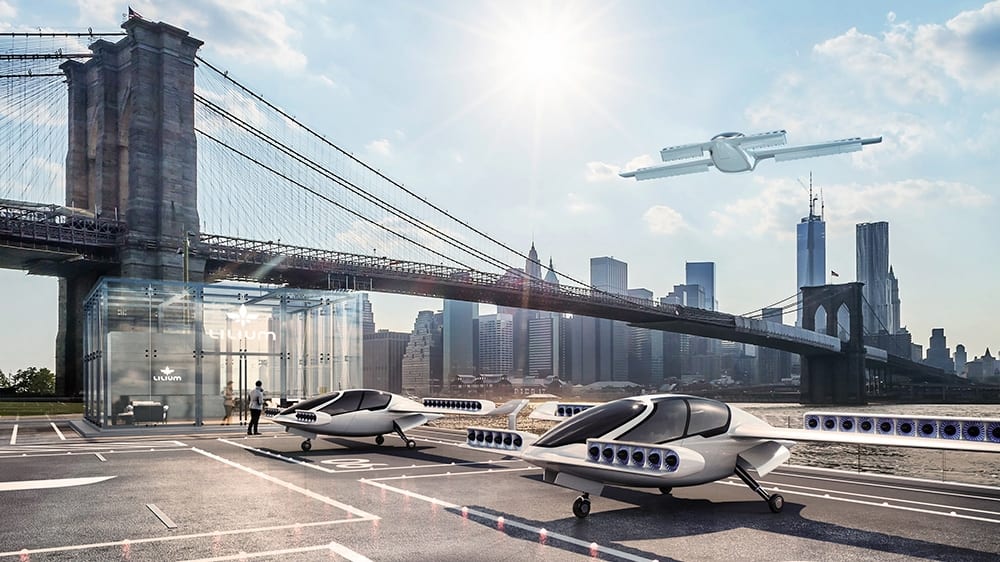
#1 – Fist full EV VTOL Jet take to the skies
A German startup, Lilium, founded in 2015 with the intent to develop the first fully electric vertical take-off and landing (VTOL) jet this week completed its first successful test flight. The vehicle, named Eagle, a two-seater prototype completed its first test flight in Bavaria, Germany. The test flight included a range of advanced maneuvers, including its signature mid-air transition from hover mode to wing-borne forward flight.
 Lilium’s business plan provides a flying five-seater taxi on demand. The Lilium Jet has a cruising velocity of 300km/h (187mph) and range of 300km. The design consists of a 10-meter wingspan, 36 engines, and works on the canard concept with powered lift.
Lilium’s business plan provides a flying five-seater taxi on demand. The Lilium Jet has a cruising velocity of 300km/h (187mph) and range of 300km. The design consists of a 10-meter wingspan, 36 engines, and works on the canard concept with powered lift.
The company beats industry heavyweights Airbus at its own game. Airbus unveiled the Airbus Pop.up during the Geneva Auto Show in 2017.
#2 – LG-Chem Q1 Sales excels
LG Chem, the Korean battery vehicle manufacturer, this week announced it’s Q1 sales valued at $5.5Bln, showing growth of 33% year-on-year. More impressive though is that the company showed an increase in operating profits of 74% year-on-year. In our view, it provides a safety margin which could point to price decreases in the expected price war, similar the solar panel market as huge new plants is coming online over the next two years.
#3 – Tesla recall a buying opportunity
Tesla this week announced one of its largest voluntary recalls for 53,000 manufactured between February and October 2016. The recall is due to a fault in a third-party supplied component, potentially resulting in the handbrake not releasing. The recall is not viewed as negative and hardly had an impact on the share price as the company closed near its record price of $307.71 set earlier the week, still very well on the way to our first target of $320.
Tesla’s announcement that it would unveil its Semi-truck in September had analyst very excited, speculating that it would add billions to the companies bottom line and disrupt the sector. The company is expected to lease the batteries at $0.25 per mile saving trucking companies the $0.50 fuel charge.
#4 – Q1 EV sales for France, German, and China, two out three ain’t bad.
German (#9 on Top EV list), French (#7 on Top EV list), and Chinese (#1 on Top EV list) EV sales for Q1 was released this week. Both China and Germany saw huge year-on-year increases, while French EV sales flatlined. Read our blogs for a detailed breakdown of the sales.
#5 – More Concept’s and a few production-ready vehicles at Shanghai Auto Show
The New York and Shanghai Auto Show’s provided many newsworthy releases related to electric vehicle strategies, concept cars, and some productions cars. Although the New York auto show had all thirty plus electric vehicles available for sale in the State on view, the Shanghai Auto Show were the place to be for electric vehicle enthusiast. The VW Group teased its Audi eTron SUV and VW I.D. CROZZ concepts, which is only expected by 2019. Tired of all these old auto companies releasing concept after the other without having real competition for the Tesla available? Two production ready vehicles from newcomers Lucid Motors and NextEV‘s NIO brand were unveiled at the Chinese event. NIO’s ES8 seven seater SUV is expected to be available in China by the end of the year. The company also announced that it would add ten more units to its fleet of six EP9 supercars, priced at $1.48 million.
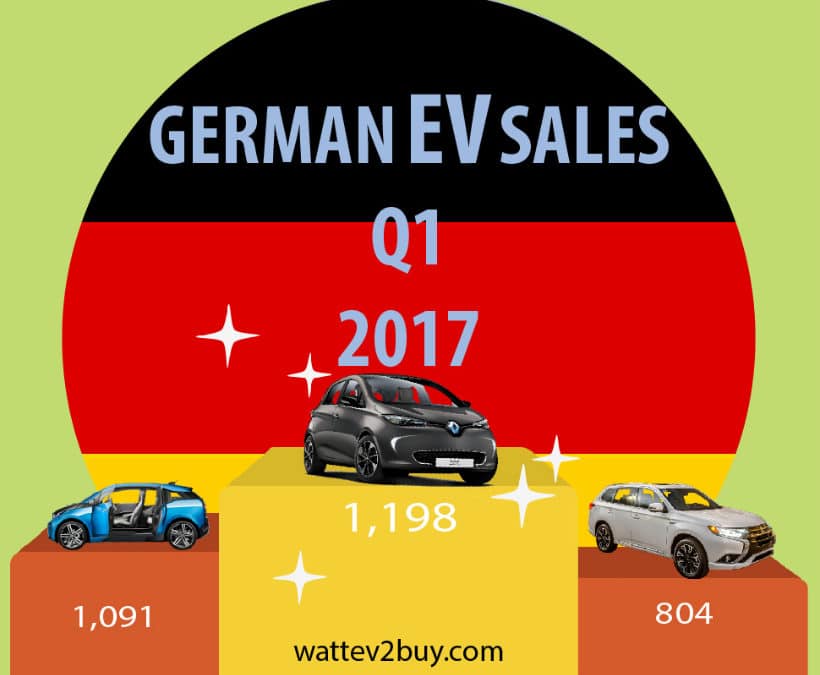
EV sales in Germany nearly doubled to around 10,100 units from a year ago when only 5,700 electric vehicles were sold. Battery Electric Vehicles (BEV) outsold Plug-in Hybrid Electric Vehicles (PHEV) by 10% on the back of strong sales of the new Renault Zoe Z.E. 40. The New Zoe has an NEDC range of 248mi / 400km, which is more likely an EPA (real world) range of 190mi / 300km.
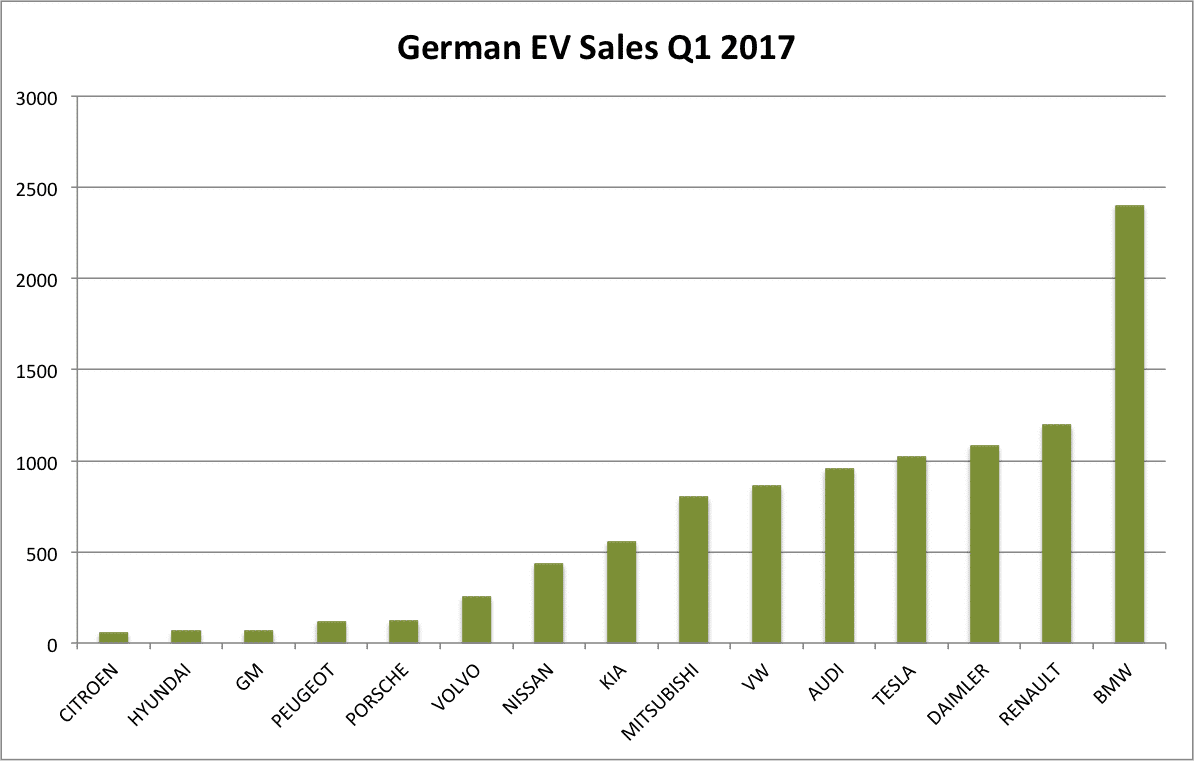
The worst-performing models were the VW Golf GTE, selling over 80% less than a year ago, the VW e-Golf, selling 43% less and the BMW X5 XDrive40e losing 33% of its sales. The Nissan Leaf also underperformed, partly due to the New Renault ZOE and partly due to a new version being expected later the year.
The BMW i3 took the second position with nearly 1100 units sold, of which 62% were the BEV version, an opposite scenario as for the same period last year when 68% of all BMW i3s sold were the range extending version.
New models for the quarter includes the Opel Ampera-e (Chevy Bolt), Hyundai Ioniq Electric, Mini Countryman, BMW 530e, BMW 740e, Tesla Model X, Mercedes-Benz GLC350e and E350e. The best performers from the newcomers were the Tesla Model X, a BEV and Mercedes-Benz GLC350e, a PHEV. The worst performers were the two new BEVs, the Opel Ampera-e and Hyundai Ionic, both selling only 68 units each. The BMW 530e was the worst performing new PHEV, with only 62 units sold.
The worst performing brands were VW, Porsche, and Nissan, which incidentally were the only brands losing market share in this record breaking quarter. Of further significance is that both Porsche and VW are indigenous to Germany. Even including Audi’s sales data to that of VW and Porsche still puts the VW Group at the bottom of the list with a mediocre 2.2% growth year-on-year.
All-in-all the Q1 2017 sales data points to a record-breaking year for the German EV market, which could help it ascend from its 9th position on the list of Global EV sales by country, should UK EV sales flounder.
